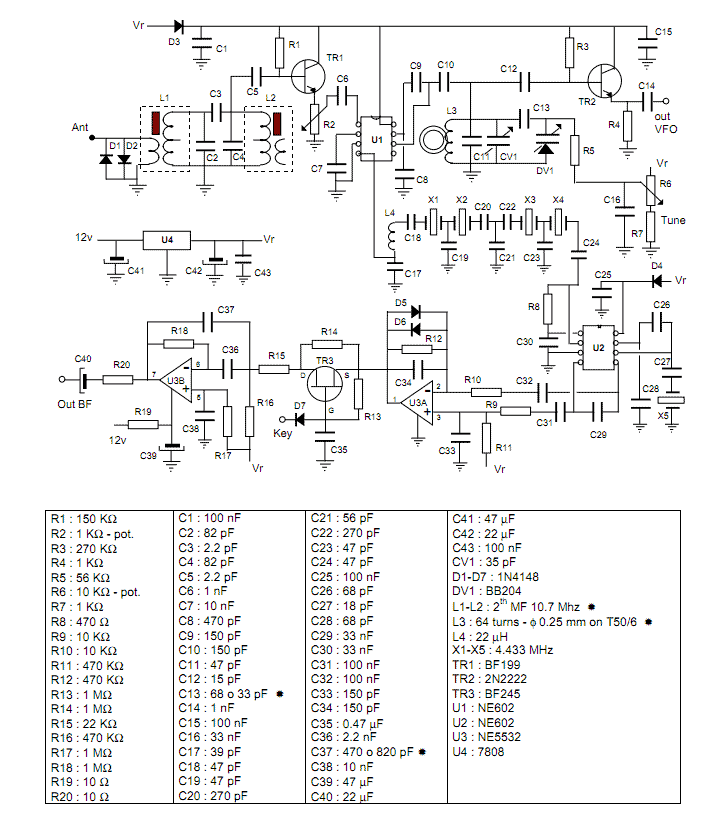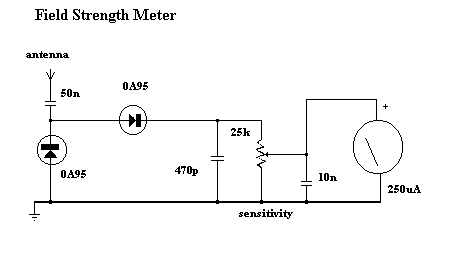
Field-strength meters

This circuit, housed in a compact plastic enclosure, is designed for portability and can be easily placed inside a bag or handbag. A small magnet is positioned near a reed switch and is attached to the individual carrying the bag via a thin cord. In the event of an abrupt snatching of the bag, the magnet loses contact with the reed switch (SW1), causing it to open. This action initiates oscillation in the circuit, resulting in a loud alarm sound emitted from the loudspeaker. This device can also serve as a signal for the opening of a door or window. It can be mounted on the frame, with the magnet placed on the movable part, ensuring that the magnet and reed switch are in close proximity when the door or window is closed. A complementary transistor pair is configured as a high-efficiency oscillator, which directly drives a small loudspeaker. The low component count and 3V battery supply allow for a very compact design. When utilized as an anti-bag-snatching device, SW1 can be substituted with a 3.5mm mono jack socket, and the magnet can be replaced with a 3.5mm mono jack plug, with its internal leads shorted. The jack plug can be connected to the thin cord, etc.
The circuit operates on a simple principle of magnetic contact interruption, utilizing a reed switch that is sensitive to the presence of a magnetic field. When the magnet is in close proximity to the reed switch, it keeps the switch closed, allowing current to flow through the circuit. This is crucial for the normal operation of the oscillator circuit formed by the complementary transistor pair, which is responsible for generating the audio signal that drives the loudspeaker.
In the event of a bag snatching, the sudden movement causes the magnet to separate from the reed switch, leading to the opening of SW1. This triggers the oscillator to activate, producing a loud alarm sound that serves as a deterrent against theft. The loudspeaker is designed to produce a significant sound level, ensuring that the alarm is audible in various environments.
For applications involving door or window security, the configuration allows for easy installation. The box can be mounted securely on the stationary part of the door or window frame, while the magnet is attached to the movable part. This setup ensures that when the door or window is closed, the reed switch remains closed, and the circuit remains inactive, conserving battery life until the switch is opened.
The use of a 3V battery supply not only minimizes the physical size of the device but also ensures that it remains lightweight and easy to carry. The option to replace the reed switch with a 3.5mm mono jack socket provides flexibility in the design, allowing for customization based on user needs or preferences. This modular approach enhances usability, making it ideal for various applications beyond just anti-theft measures. Overall, this circuit represents an efficient and practical solution for personal security and alert systems.This circuit, enclosed in a small plastic box, can be placed into a bag or handbag. A small magnet is placed close to the reed switch and connected to the hand or the clothes of the person carrying the bag by means of a tiny cord. If the bag is snatched abruptly, the magnet looses its contact with the reed switch, SW1 opens, the circuit starts osc
illating and the loudspeaker emits a loud alarm sound. This device can be very useful in signalling the opening of a door or window: place the box on the frame and the magnet on the movable part in a way that magnet and reed switch are very close when the door or window is closed. A complementary transistor-pair is wired as a high efficiency oscillator, directly driving a small loudspeaker.
Low part-count and 3V battery supply enable a very compact construction. If the circuit is used as anti-bag-snatching, SW1 can be replaced by a 3. 5mm mono Jack socket and the magnet by a 3. 5mm. mono Jack plug with its internal leads shorted. The Jack plug will be connected with the tiny cord etc. 🔗 External reference
The circuit operates on a simple principle of magnetic contact interruption, utilizing a reed switch that is sensitive to the presence of a magnetic field. When the magnet is in close proximity to the reed switch, it keeps the switch closed, allowing current to flow through the circuit. This is crucial for the normal operation of the oscillator circuit formed by the complementary transistor pair, which is responsible for generating the audio signal that drives the loudspeaker.
In the event of a bag snatching, the sudden movement causes the magnet to separate from the reed switch, leading to the opening of SW1. This triggers the oscillator to activate, producing a loud alarm sound that serves as a deterrent against theft. The loudspeaker is designed to produce a significant sound level, ensuring that the alarm is audible in various environments.
For applications involving door or window security, the configuration allows for easy installation. The box can be mounted securely on the stationary part of the door or window frame, while the magnet is attached to the movable part. This setup ensures that when the door or window is closed, the reed switch remains closed, and the circuit remains inactive, conserving battery life until the switch is opened.
The use of a 3V battery supply not only minimizes the physical size of the device but also ensures that it remains lightweight and easy to carry. The option to replace the reed switch with a 3.5mm mono jack socket provides flexibility in the design, allowing for customization based on user needs or preferences. This modular approach enhances usability, making it ideal for various applications beyond just anti-theft measures. Overall, this circuit represents an efficient and practical solution for personal security and alert systems.This circuit, enclosed in a small plastic box, can be placed into a bag or handbag. A small magnet is placed close to the reed switch and connected to the hand or the clothes of the person carrying the bag by means of a tiny cord. If the bag is snatched abruptly, the magnet looses its contact with the reed switch, SW1 opens, the circuit starts osc
illating and the loudspeaker emits a loud alarm sound. This device can be very useful in signalling the opening of a door or window: place the box on the frame and the magnet on the movable part in a way that magnet and reed switch are very close when the door or window is closed. A complementary transistor-pair is wired as a high efficiency oscillator, directly driving a small loudspeaker.
Low part-count and 3V battery supply enable a very compact construction. If the circuit is used as anti-bag-snatching, SW1 can be replaced by a 3. 5mm mono Jack socket and the magnet by a 3. 5mm. mono Jack plug with its internal leads shorted. The Jack plug will be connected with the tiny cord etc. 🔗 External reference





